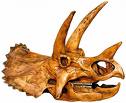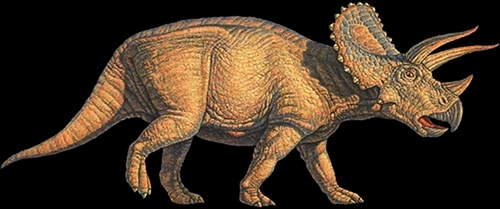Dinosaur Horns
Homepage > Dinosaur Anatomy - Dinosaur
Horns
 Dinosaur horns were made up of two parts, an outer covering and an inner
core. These similarities may be found in modern mammals such as antelope.
Dinosaur horns grew larger and larger as the dinosaur aged. These horns
were not shed like the antlers of today's deer.
Dinosaur horns were made up of two parts, an outer covering and an inner
core. These similarities may be found in modern mammals such as antelope.
Dinosaur horns grew larger and larger as the dinosaur aged. These horns
were not shed like the antlers of today's deer.
Interesting Fact
[Triceratops brow horn grew
up to 3.4 feet (1 meter) in length. Its protective frill, skull and brow
horns were one solid piece. Its skull weighed 1,000 pounds and was six
times thicker than a human skull. When comparing Tricaratops' horns with
modern mammals, we find that rhinos' horns are made out of hair material,
and elephant's horns are made out of ivory, but Triceratops' horns are
made out of solid bone. These horns were able to withstand up to 36,000
pounds of pressure.]
Horns were most common among the herbivore dinosaurs. Using some of these large, sharp horns against predators may have been an efficient way of defense. During Tyrannosaurus' time, Triceratops outnumbered Tyrannosaurus 10 to 1. A statistic that testifies how effective Triceratops was when defending against predators.
Triceratops may have also used its horns against other members of its family. Perhaps locking horns in a trial of strength, the same way antelopes do today.
